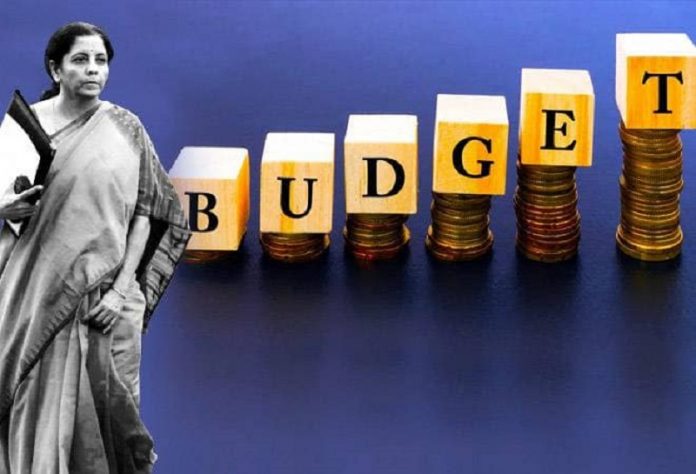Our Finance Minister Nirmala Sitharaman on Friday presented her maiden budget. From the beginning of her presentation, she reiterated Narendra Modi‘s dream of developing India into a $5 trillion economy by 2025. The finance minister’s budget team comprised of the Minister of State for Finance, Anurag Singh Thakur and Chief Economic Advisor Krishnamurthy Subramaniam. The official team assigned to roll out the budget was led by Finance Secretary Subash Chandra Garg, Expenditure Secretary Girish Chandra Murmu, Revenue Secretary Ajay Bhushan Pandey, DIPAM Secretary Atanu Chakraborty, and Financial Services Secretary Rajiv Kumar.
Here are the highlights of Nirmala Sitharaman’s budget for 2019-20:
- India’s economy will touch $3 trillion in this year itself. Our economy is the 6th largest in the world up from 11th , five years ago.
- Rs. 10,000 crore allotted to the FAME II scheme that aims to encourage faster adoption of electric vehicles by the means of incentives and changing infrastructure.
- A nominal basic customs duty has been imposed on products such as tobacco, crude oil. Cashew kernels, PVC, vinyl flooring, metal fittings, mountings for furniture, synthetic rubber, optical fibre cable, CCTV cameras, IP Camera, network and digital cameras and metal slabs will attract a higher customs duty. The customs duty on gold, silver and platinum has been set at 12.5% up from the earlier 10%. A 5% customs duty is also going to be levied on imported books to encourage domestic publishing and printers.
- Cess on petrol and diesel imposed that will raise their prices by Rs.1.
- Income tax slab rates kept unchanged.
- To incentivise affordable housing, a deduction of Rs. 1.5 lakh on loans can be availed on interest payments on loans borrowed up to March 2020 for purchase of a house up to Rs. 45 lakh.
- Additional income tax deduction of Rs 1.5 lakh on interest paid on loans borrowed for the purchase of electric vehicles.
- To discourage the practice of making business payments in cash, the government proposes to levy TDS of 2% on cash withdrawal exceeding ₹1 crore in a year from a bank account.
- The PAN Card and Aadhar card are now interchangeable and the Aadhar number can be quoted while filing returns.
- Public sector banks will be provided Rs 70,000 crores to boost capital and improve credit.
- A new series of ₹1, ₹2, ₹5,₹10 and ₹20 coins released by the PM on 7th March 2019 will be easily identifiable by the visually impaired.
- As part of India’s mission to increase its global footprint, India had planned to open 18 new embassies in the African subcontinent of which five have been opened in the 2018-19. Four more embassies will be opened in the upcoming year.
- Regulation authority over housing finance sector to be returned from National Housing bank to the RBI.
- To encourage women entrepreneurs, Women Self Help groups, ‘Interest Subvention Program’ to be expanded to all districts across India.
- Exclusive TV programme for startups designed by startups will be started.
- Proposal to issue Aadhar to NRI’s without 180 days mandatory waiting period.
- Under “Jal Jeevan Mission”, water management to be developed and water to be brought to all household by 2024.
- A policy framework to be brought to make India a global hub of aircraft financing and leasing activities.
- The second phase of PMAY proposed for about 1.95 crore beneficiaries.
- Proposal to increase minimum public shareholding in listed companies from 25% to 35%.
- Pension benefits will be extended to 3 crore retail traders with an annual turnover of less than ₹1.5 crore.
- Proposal for an investment of 50 lakh crores into the railway infrastructure between 2018 and 2030.
- Proposal for change in tenancy laws and current laws were termed “archaic”.
- Proposal for formation of New Space India Ltd. to tap into benefits of ISRO and commercialise space programme.
- By 2022 every single rural family unless unwilling to, will have an electricity connection and clean cooking facilities.
- ₹80,250 crores to be invested in upgradation of 1.25 lakh km of rural roads
- Proposal for the setup of 80 livelihood incubators and 20 tech incubators to develop 75,00 entrepreneurs in agriculture.
- National sports education board to be set up under Khelo India scheme.
- Government to invest ₹100 lakh crores in infrastructure over the next five years.
- Budget promises to bring down fiscal deficit to 3.3%of GDP down from 3.4%.
Whilst the ruling government has been quick to term the budget a ‘citizen-friendly’ and ‘farmer-friendly budget’, many economists have found the budget to be vision-less. The budget has been termed as an increment to the interim budget but nothing radical and the budget has been assessed as not having taken any bold steps. However, it remains to be seen as to how the budget pans out and if it is the budget that Indians need.



























